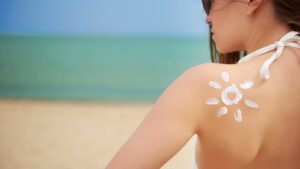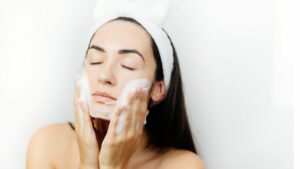If You Have Acne, Be Careful In The Sun!

Ever heard of the rebound effect? It is also called boomerang effect. It describes a counter-reaction of what you actually expected. This is exactly what happens when UV rays hit acne. Although there is an initial improvement, the skin’s appearance soon worsens again.
Teenagers with acne on their faces are often sent out into the sun by their mothers to dry up the pimples and pustules. In a way, this is true, because UV rays actually have anti-inflammatory and antibacterial effects. They switch off, so to speak, the micro-organisms that are involved in the development of pimples and blackheads. Therefore, the skin condition actually improves – for now.
However, the success is only temporary. However, many sufferers are deceived by this and abandon their usual anti-acne care. The disappointment comes with the end of summer when the acne is back and often even worse – it really “blooms”. This is called the rebound effect. This phenomenon is also known in pharmacology, when an abrupt discontinuation of a drug is followed by an exaggerated counter-reaction.
“However, with too much UV radiation from the sun, there is a rebound effect, especially in autumn. Therefore, it is important to always apply a very high level of sun protection,” confirms Judith Horzel, pharmacist and senior medical manager at the French Beauty Brand Pierre Fabre.
The best success is achieved with a dermatological problem-solving brand. In the case of acne, sun protection products should not only contain an effective UVA-UVB broadband filter, but also substances that eliminate skin impurities and ensure that they do not reappear. Myrtacin and Celastrol, as used by the brand “Ducray”, are such active substances. They have an anti-inflammatory effect and prevent the formation of the biofilm by Propionibacterium acnes, which is partly responsible for acne.
What happens when UV light hits acne skin?
As already described, the skin’s appearance improves in the short term, as the sun dries out the pimples. But the skin tries to protect itself from the rays and heat of sunlight by thickening and trapping the sebum produced and bacteria in the skin. While this temporarily makes the skin look nicer, it also clogs pores. If you then use an inappropriate sunscreen and even the wrong factor, the thickening of the skin layer is additionally promoted. The sweat factor should not be underestimated either: sweating is basically good because it opens the pores and flushes dirt to the outside. However, if the sweat dries on the skin, and even more so at warm temperatures, the bacteria multiply.
What is trapped eventually wants to see the light of day. In autumn, sebum and bacteria therefore push their way to the surface. This brings back what had supposedly disappeared in the summer: enlarged pores, pimples and blackheads – and in many cases even more pronounced than before the summer. The most beautiful rebound effect has occurred! Another danger of over-extensive sunbathing with acne is that, in addition to new inflammations, hyperpigmentation and dark spots can result from excessive melanin production. This aesthetic problem is often more complicated to solve than the acne itself.
Do not leave the usual skincare routine
To avoid acne outbreaks after summer in advance, it is important to maintain your usual skincare routine for day and night. And not only in the summer everyday life, but also on vacation. When it comes to sunscreens, make sure they are suitable for acne skin and do not contain problematic additives such as fats, emulsifiers and preservatives. They often have a comedogenic effect, meaning they clog pores and thus promote acne.
“The greasier and heavier a sunscreen, the more likely it is to cause problems,” he says. “Apply a slightly lighter product with a lower UV filter more often rather than a heavy product with a high SPF. Waterproof and so-called ‘all day’ products are also problematic,” says Dr. Jetske Ultee, research physician in cosmetic dermatology in Rotterdam.
Choosing the wrong product poses another risk for acne sufferers in particular: they can get sun acne because they are particularly susceptible to it. The medical term is acne aestivalis, better known as acne Mallorca. Although it is not acne in the classical sense, it also causes inflammation of the skin. It is caused by the “toxic” combination of intense UVA sun radiation and the fats or emulsifiers in the sunscreen.
The result is a rash with inflammatory pimples on the face, back and chest. Mallorca acne disappears only after you have avoided the sun for several days. If you are prone to sun acne, you should definitely take it easy in the summer and especially on vacation – with short UV exposures and never “fry” in the midday heat anyway. And very importantly, if you have applied sunscreen: Thoroughly cleanse the skin with a mild cleanser every evening!

CultureAndCream Author from Munich
To travel during my profession as a beauty journalist was never enough for my. Also my six month on a world trip didn’t do it. It always attracts me to other cities, foreign countries, on roadtrips and places I don’t know yet. But I am not only interested in “culture” and “cream”, I am also fascinated by people who have stories to tell . Such unique experiences I want to share with you.

